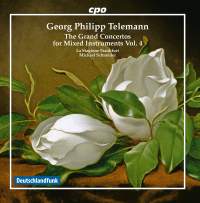Texte paru dans: / Appeared in: |
|
|
Outil de traduction ~ (Très approximatif) |
|
|
Reviewer: Barry
Brenesal Michael Schneider and La Stagione Frankfurt continue here to move through the concertos of Telemann, undaunted by the sheer size of the task. Listening to all four recorded volumes in succession reinforces a sense of their invention, and their structural and stylistic variety.
While everything on this disc
is distinctive, two works are of particular interest. The seven-movement
Concerto in F Major, TWV 54:F1, survives in two versions that have been
arranged from an original which cannot be reconstructed at this time. It is
one of those roughly 700 colorful overture-suites Telemann wrote, of which a
quarter survive. As with so many of the other, similar works he composed,
the concerto mixes national styles with suave ease and creativity, including
a very Neapolitan serenade in which a recorder and violin duet over plucked
strings, a delicate French loure, and a galloping gigue finale led by paired
horns. The other work I would single out for especial attention is the Concerto in E Minor, TWV 53:e1, for two flutes and violin. It is a quintessentially Neapolitan da chiesa piece, a wistful prelude leading to a learned fugue, a chromatically expressive passacaglia, and a quirky gigue. I have only praise for Schneider and La Stagione Frankfurt, the ensemble he founded in 1988. The soloists are technically expert, while the members perform as a unit with discipline and energy. There is never any question of finales being slowed because of difficult horn parts, nor of unison marcato attacks that draw attention to themselves and away from the musical argument. Slower, repeated solo passages are allowed to expand gracefully through a discreet use of ornamentation. Tempos are always appropriate and rhythms carefully defined. Timings are on the short side, which is to be regretted in performances as fine as these.
The
engineering is forward, and well balanced between soloists and soloists with
ripieno. If you’re familiar with this series, it suffices to say this lives
up to the quality of the previous three releases. | |
|
Support us financially by purchasing this disc from eiher one of these suppliers. Un achat via l'un ou l'autre des fournisseurs proposés contribue à défrayer les coûts d'exploitation de ce site. |
|
|
|
|
|
Cliquez l'un ou l'autre
bouton pour découvrir bien d'autres critiques de CD |
|




